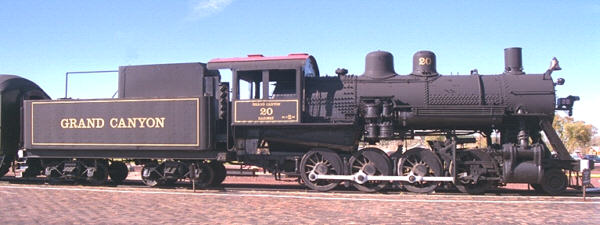|
Grand Canyon Railway |
|---|

The historic Grand Canyon Railway provides rail service between its depot in Williams, Arizona and the depot at Grand Canyon Village inside Grand Canyon National Park.
Travel to and from the Canyon is completed in meticulously restored coaches dating back to the late 1800's. The type of locomotion used depends on the total number of people travelling to the Canyon on any given day, which varies depending on the time of the year and the day of the week. Typically, when the demand is low, only the steam engine is used to pull the coaches, except in the winter time as the steam engine apparently has problems with iced up tracks on some of the steeper grades. When the steam engine cannot be used alone it is replaced or augmented by a diesel locomotive, circa 1950.
My wife and I along with two other family members took this trip in September, 1999 and a report of the experience can be had by clicking here.
Coach class: adults, $58 plus tax and Grand Canyon National Park
entrance fee; children (3-16), $25 plus tax
Club class upgrade from coach add $21 per person
Coconino Car upgrade, add $58 per person
Coconino Dome upgrade, add $79 per person
Chief class (Parlor Car) upgrade from coach add $89 per person
All rates are plus state and local taxes and national park entrance fee
For reservations and additional information call 1-800-THE-TRAIN
2003 schedule:
The trains typically leave Williams at around 10 AM and arrive at the Canyon just after noon, at 12:15.
The return trip leaves Grand Canyon Depot around 3:30 PM and arrives back at Williams by 5:45 PM.
From January 1 up to Memorial Day weekend will be using 1950 diesel engine.
From Memorial Day weekend through the summer season (September) will use the steam engine.
Grand Canyon Railway 2003 / 2004 fares
The Grand Canyon Railway began its existence as a spur route of the Atchison, Topeka and Santa Fe Railroad that was used to transport supplies and people to the mining town of Anita, Arizona. At that time the railroad was called the Santa Fe & Grand Canyon even though the tracks ended at Anita, 45 miles north of Williams but still some 15 or more miles south of the Grand Canyon.
In September, 1901 the Santa Fe completed an extension of the line which allowed the railroad to reach the south rim. Upon arrival at the south rim the railroad was rename to be the Grand Canyon Railway. At that time Grand Canyon Village consisted of little more than some small one and two room dwellings constructed of wood and canvas. These simply dwellings were dubbed the Bright Angel Hotel and were probably somewhat more comfortable than tents but not quite as comfortable as a true log cabin would have been.
Things began to change very quickly. They would have to if the railroad wanted to attract tourist to the Grand Canyon. By 1903 the first of Fred Harvey's establishments at the Grand Canyon, the El Tovar Hotel, had been constructed and was ready to receive guests. Staying at the El Tovar must have been something in those early days. It was not your average American of those days that could afford to make the trip all the way to the Grand Canyon. It was primarily only the high society folk of those days that would be staying at the El Tovar.
The arrival of the railroad and the Fred Harvey Company took its toll on some of the smaller businessmen of the area. The stage lines, which had been the primary link with civilization in Flagstaff and Williams, went out of business. Some of the miners who remained at the Canyon when the bottom fell out of the copper market in 1907 had since taken to the tourist business themselves. Men like Peter D. Berry, who had built and operated the Grandview Hotel out at Grandview Point; John Hance, who brought visitors down to his ranch in the bottom of the Canyon and from there to the river; and William Wallace Bass, who operated similar tourist facilities in the western portion of the Canyon, could not compete with Fred Harvey and were soon out of the tourist b usiness.
The Grand Canyon Railway remained the primary method for getting to the Canyon until the mid 1920's when the first automobiles, the Model Ts, began arriving. As the number of automobiles continue to increase the roads leading to the Canyon were improved which attracted more and more visitors. The railroad held on though, until in 1968 when it could no longer survive, and went out of business.
In 1991, the right of way was purchased, and the railway was reborn. The environmental movements began to make people think more and more about not using their automobiles when alternative forms of transportation were available and the Park Service added its own initiative by announcing that the Canyon was simply becoming too congested as a result of too many people bringing too many automobiles to the Canyon during the prime tourist season. The Grand Canyon Railway is now doing very well again and, in the summer months and many times on the weekends in spring and fall, it is not uncommon to see the train pull into Grand Canyon Depot hauling 10-15 coaches and hundreds of visitors.
|
|
|---|
|
|---|